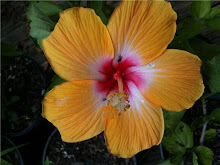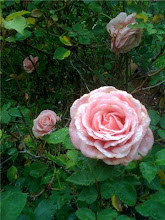
I received "Outstanding Alumni of the Year" award from my graduate school this past weekend in Minneapolis, Minnesota. Upon check in, I heard the front desk person say "You are staying in the executive corner suite" and that's when I thought, who me?? Really??
The room was gorgeous - views and views of downtown Minneapolis. Friday night, I attended the banquet where I said a few words and met the wonderful board and faculty of the university.
Saturday was a free day with university socials going on in the late evening. Herbhusband and I toured the town. We took the light rail to the Mall of America and stayed there for about an hour and a half when we both said let's go! We want to explore the nature scene!


We hopped on a shuttle and found ourselves in lovely park where our herb adventure took us to a more fulfilling place than any mall could offer.
 . As we began our walk, we could see the downtown sky line through the trees and over the water. The water was so beautiful and the weather was crisp and breezy. On our herb walk we met up with clover growing along the pathways - for a Texan, seeing clover growing so lushly was heaven! We stayed and took many pictures and appreciated a stand of bee balm, yarrow, dandelion and plantain.
. As we began our walk, we could see the downtown sky line through the trees and over the water. The water was so beautiful and the weather was crisp and breezy. On our herb walk we met up with clover growing along the pathways - for a Texan, seeing clover growing so lushly was heaven! We stayed and took many pictures and appreciated a stand of bee balm, yarrow, dandelion and plantain. Bee Balm:
 I just love Bee Balm (Monarda) also known as Horsemint by some. In a previous posting I showed you how to make Bee Balm honey and after using this honey each time my throat feels a little funny I thank my herbal teacher, Nicole Telkes, for turning me on to such an delicious and easy way to ward off sore throats. A poultice can also be used for headaches. You would simply infuse bee balm in hot water and soak a cloth in the infusion and apply directly to the skin. Bee Balm has been used by Native Americans to fight mouth and throat infections - the active agent here being thymol, which has antiseptic and antimicrobial properties.
I just love Bee Balm (Monarda) also known as Horsemint by some. In a previous posting I showed you how to make Bee Balm honey and after using this honey each time my throat feels a little funny I thank my herbal teacher, Nicole Telkes, for turning me on to such an delicious and easy way to ward off sore throats. A poultice can also be used for headaches. You would simply infuse bee balm in hot water and soak a cloth in the infusion and apply directly to the skin. Bee Balm has been used by Native Americans to fight mouth and throat infections - the active agent here being thymol, which has antiseptic and antimicrobial properties. Clover:
 This particular clover is Trifolium repens, part of the pea family (Fabaceae). My favorite clover is red clover; however this lower growing clover offers white creamy flowers and is often used as a pasture feed. It can be a wonderful addition to an herb garden, as seen here, since it introduces nitrogen to the soil and can keep out unwanted seedlings/weeds. You want soil rich in nitrogen to keep your soil healthy and able to defend itself against disease. Clover is high in protein and to eat this particular type of clover, you must boil it for at least 5 minutes since it's hard to digest. You could also sauté the leaves and/or roots with other veggies to add more protein in your diet.
This particular clover is Trifolium repens, part of the pea family (Fabaceae). My favorite clover is red clover; however this lower growing clover offers white creamy flowers and is often used as a pasture feed. It can be a wonderful addition to an herb garden, as seen here, since it introduces nitrogen to the soil and can keep out unwanted seedlings/weeds. You want soil rich in nitrogen to keep your soil healthy and able to defend itself against disease. Clover is high in protein and to eat this particular type of clover, you must boil it for at least 5 minutes since it's hard to digest. You could also sauté the leaves and/or roots with other veggies to add more protein in your diet. Yarrow:
 I just love the feathery fern like leaves on the Yarrow. Yarrow is quite interesting in that internally, its actions are hypotensive, astringent, diuretic, and antiseptic. It has been used to assist with high blood pressure and has a reputation for being effective in bringing down fevers. It is said that drinking the tea can help decrease menstruation as well as helping expel afterbirth. It has also been used to shrink hemorrhoids. Externally, it is often used to stop bleeding wounds (astringent).
I just love the feathery fern like leaves on the Yarrow. Yarrow is quite interesting in that internally, its actions are hypotensive, astringent, diuretic, and antiseptic. It has been used to assist with high blood pressure and has a reputation for being effective in bringing down fevers. It is said that drinking the tea can help decrease menstruation as well as helping expel afterbirth. It has also been used to shrink hemorrhoids. Externally, it is often used to stop bleeding wounds (astringent). Dandelion:
 Dandelion has such a bad rap! I can't get over how this healing plant has been labeled the enemy for so many years. Dandelion (Taraxacum officinale) gets it's name from the tooth like edges on its leaves. In Spanish it can be broken down to Dent de Leon or Tooth of the Lion. All parts of the Dandelion are edible. The fresher newer leaves can be eaten directly in salads or sautéed with a little olive oil and salt and pepper for a wonderful change to your culinary routine. The flowers can be tossed into salads, too. But the roots....ahhh the roots is where the action's at! The roots can be made into tincture and the tincture (a bitter) can be taken just before meals to stimulate bile production and help aid digestion. The roots also have caffeine and can be roasted and substituted for coffee for people who need to back away from coffee for whatever reason. The roots are also said to help with liver detoxification and kidney health. It's a tonic so it's actions are best when used in small doses over long periods of time. There is so much that can be said about our herbal friend dandelion, that I will set aside time and focus a posting featuring dandelion in its full glory.
Dandelion has such a bad rap! I can't get over how this healing plant has been labeled the enemy for so many years. Dandelion (Taraxacum officinale) gets it's name from the tooth like edges on its leaves. In Spanish it can be broken down to Dent de Leon or Tooth of the Lion. All parts of the Dandelion are edible. The fresher newer leaves can be eaten directly in salads or sautéed with a little olive oil and salt and pepper for a wonderful change to your culinary routine. The flowers can be tossed into salads, too. But the roots....ahhh the roots is where the action's at! The roots can be made into tincture and the tincture (a bitter) can be taken just before meals to stimulate bile production and help aid digestion. The roots also have caffeine and can be roasted and substituted for coffee for people who need to back away from coffee for whatever reason. The roots are also said to help with liver detoxification and kidney health. It's a tonic so it's actions are best when used in small doses over long periods of time. There is so much that can be said about our herbal friend dandelion, that I will set aside time and focus a posting featuring dandelion in its full glory. Plantain:
 Plantain (Plantago major) can be gathered throughout the summer. The leaves are often used for their healing properties, especially with burns and bites. Plantain can be gently chewed and applied directly to the burn or bite when exploring the outdoors and when there isn't anything else to assit you with your dilemma. Taken internally, it is said to assit with coughing and acts as an expectorant and a soother of inflamed membranes. When I burned my fingers, I quickly turned to Plantain and added it to my healing remedy. (By the way, my fingers did not bliser at all - whew!). On a plant walk with Herbalist Christopher Hobbs, he noted Plantain's soothing actions by stating how it has been used to assist with gut irritations and diahrea. Overall, though - I think most people prize plantain for it's soothing and healing benefits on irritated and inflamed skin.
Plantain (Plantago major) can be gathered throughout the summer. The leaves are often used for their healing properties, especially with burns and bites. Plantain can be gently chewed and applied directly to the burn or bite when exploring the outdoors and when there isn't anything else to assit you with your dilemma. Taken internally, it is said to assit with coughing and acts as an expectorant and a soother of inflamed membranes. When I burned my fingers, I quickly turned to Plantain and added it to my healing remedy. (By the way, my fingers did not bliser at all - whew!). On a plant walk with Herbalist Christopher Hobbs, he noted Plantain's soothing actions by stating how it has been used to assist with gut irritations and diahrea. Overall, though - I think most people prize plantain for it's soothing and healing benefits on irritated and inflamed skin. Cottonwood:


Cottonwood is a member of the Willow family. The Willow family is known for it's analgesic, anti-inflammatory, and astringent properties. Like aspirin, Cottonwood has been used to reduce fevers, headaches, arthritis and other inflammations. Cottonwood bark can be made into salves, creams and tinctures and it's said to be very helpful in relieving inflammation and pain associated with arthritis. Cottonwoods love to grown near water so if you see one, you know water is very near. Cottonwood is very much like aspirin - in the way it helps the body with pain. All parts of the plant can be used; however, not all parts of the plant can be made into healing remedies the same way. The bark may be pretty difficult to digest and may not settle well when taken internally whereas a tea made with the leaves has been taken internally by some with good results.
After gazing at these magnificent herbs, we crossed the bridge into what is know as "the island" of lush garden homes within the Mississippi River.
 The bridge was gorgeous; a perfect structure to stop and look at all the wildlife around the area. As we strolled along the bridge we entered the island where the homes were literally picture perfect! I loved seeing homes flanked by echinacea, cosmos, grape vines, leatris, yarrow, phlox, thyme and mints! It simply was heavenly - I only wish I could have gardens like this without fences in Texas - the deer just won't allow.
The bridge was gorgeous; a perfect structure to stop and look at all the wildlife around the area. As we strolled along the bridge we entered the island where the homes were literally picture perfect! I loved seeing homes flanked by echinacea, cosmos, grape vines, leatris, yarrow, phlox, thyme and mints! It simply was heavenly - I only wish I could have gardens like this without fences in Texas - the deer just won't allow. 
 As we walked around the island - I noted how charming the sidewalks were as small yellow flowers bloomed along the edges as if celebrating each step we took.
As we walked around the island - I noted how charming the sidewalks were as small yellow flowers bloomed along the edges as if celebrating each step we took. 
We continued to walk then noted how the downtown sky line looked closer to us than if we turned around and went back the way we came - so we made the executive decision to keep walking and find a bridge to take us right into downtown - no shuttle needed here! We were happy to keep on walking!

We found the bridge and saw people gathering alongside the river from one end of the bridge to the other to view the night time fireworks show. We saw many people riding their bicycles, getting toted around by horse and carriage and we even saw a party group peddling on all sides of what seemed to be a retired trolley - they Whoo Whoo'd up and down the bridge and downtown chugging beers and having a great time. The atmosphere was ripe for a great evening! Here you can see folks starting to claim their spots for the show.

After a nice glass of wine and watching the sun go down, we sat outside of a corner gourmet restaurant downtown - then we walked back to the bridge for the fireworks show. Amazing! Proud to be in Minnesota this past weekend and honored to be the recipient of the Outstanding Alumni Award, and so pleased to be able to fit in an herbal adventure to boot!














+and+wildflowers+loving+the+field.jpg)








No comments:
Post a Comment